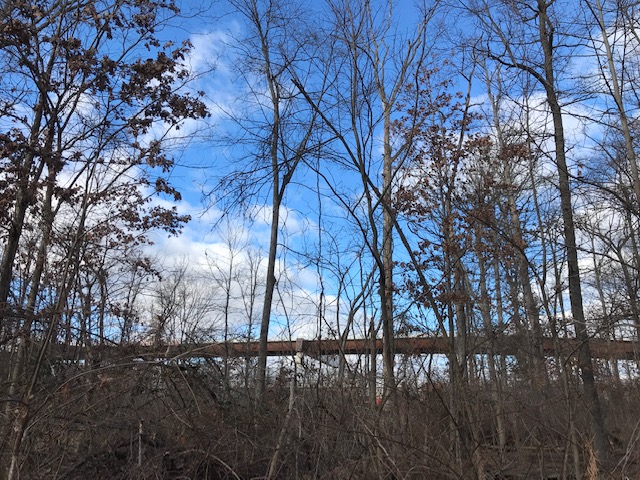
This week I had an unexpected wondrous encounter on my way to work. It was before dawn. As I was driving slowing on a quiet community road, three deer—one of them was relatively smaller—were crossing the road carefully. As soon I spotted them, I stepped on the brake and slowed the speed of my car. Watching the deer crossing the road so close, I felt so surreal as if seeing a genie popping out of a bottle. As I slowly cruised my car passing them, I saw the leader of the pack watching me vigilantly amid the darkness of the woods. Later I realized perhaps the deer wasn’t drawn to me but the headlights of my car.
Seeing deer looking for food in the woods near where I live used to be common. That was before the notorious “Transform 66 Outside the Beltway” project kicked off in late 2017. I used to wait for the county bus to the nearest metro station for my daily commute. The deer usually appeared before dawn in the woods that separated the bus terminal and the I-66 motorway. Just before the pandemic started, the landscape changed significantly. By then, I no longer commuted to my office located in District of Columbia. Trees were cut down; flowerbeds and lawn on the sidewalk became sand and gravel. At one point, at the sight of bare roads, dusty air, watery potholes and incomplete cement infrastructure, I felt like being in a homeland torn by war.
A few days ago in the new year, I walked the same path that led to the woods. I noticed rainwater was overflown from the stream, damaging the path that I normally took. I realized that the nearby road expansion project had not only changed the topography of my familiar community but also left a hidden flood and soil erosion problem. A number of tall trees were toppled because of disease and road construction.
It is wintertime. The scrawny trees without leaves remind me of the season. Without the lush woods, I’m able to see farther and hear much more from afar. I look faraway. A steel bridge emerging from the blue sky. The buzzing of vehicles on the high bridge was clear and crisp. That is the new toll road on I-66. Its birth only reminds me of how close I am to the site where wildlife has lost their habitats to humans. I miss the lush woods that buffer the noises in our community. If winter is here, spring won’t be far behind. But by springtime, we won’t have as many trees as we used to have. Some part of the woods has given way to human habitats and now the billions-dollar road project.
To my disappointment, the road expansion project does not include a firm plan for the extension of the orange metro line of the District-Maryland-Virginia metro system. Instead, what could have been the space for a metro line above ground, or a maglev train which is a more cost-effective and efficient mode of transportation, now is becoming a toll lane for the already congested interstate 66 highway system.
Have you heard of the Downs-Thomas Paradox? The paradox states that improvements in the road network will not reduce traffic congestion. Improvements in the road network can make congestion worse if improvements make public transport more inconvenient or if it shifts investment. Generally speaking, during peak hours there are more cars—no matter whether they are electric vehicles or not—on the road. They will generate more carbon emissions in total than in the off peak hour. But more highway lanes encourage more cars on the road at any given time of the day. In other words, increasing highway capacity means increasing carbon emissions. Not to mention there isn’t enough infrastructure yet for superchargers for electric cars along the busy highway.
I don’t know if I will see fewer trees and woods as a result of the urban sprawl. I do know that housing in northern Virginia is becoming more unaffordable. You may say the disease of urban gentrification that I witnessed and lived through in China is now also happening in northern Virginia and elsewhere in American suburban areas. Not everyone is winner in urbanization. The original residents in an old neighborhood usually have to move out (and usually poorly compensated) before the new community to be built.
Recently I watched a movie in which I learned about the legacy of urban planner Robert Moses who changed the landscape of New York City through power and influence. There are many lessons learned from the NYC’s changed landscape. I wonder if power and influence of both the officials and private investors are fully in play the I-66 transformation project as well. Technology is advancing comparing to Robert Moses’ time, but the psychology of power in humans has not.
When we don’t see wildlife around our neighborhoods any more, when the path in the woods is submerged in floodwater, when our winter is abnormally warmer than what we remember, will our hardwired brains begin to awake to the fact that we are the victims of the tragedy of the commons? Nobody is winner in the human-induced climate crisis.
“‘But what we need is that the only men to get power should be men who do not love it, otherwise we shall have rivals’ quarrels. […] Who else, then will you compel to undertake the responsibilities of Guardians of our state, if it is not to be those who know most about the principles of good government and who have other rewards and a better life than the politician’s?’
‘There is no one else.’“
Plato, “The Simile of the Cave” from The Symposium
